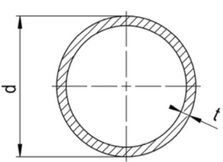It is thin walled because roughly d=200mm and t=6mm of a carbon fiber wrapped tube.
The question is, if the bending stress $\sigma$ over the cross-section (in y-direction) is linear or not.
It is clear to me that the bending moment over the cross-section must be linear (as depicted in the top picture), but because of the relation:
$\sigma_{b} = \frac{M_{b}}{W_{b}}$ and in this case $W_{b} = \frac{I_{xx}}{d/2}$
i am unsure if the bending stress would also be linear because the second moment of area $I_{xx}$ is defined as $I_{xx}=\int y^2 \, dA$ which surely isn't linear for the given thin walled tube cross-section, right?
If my train of thought is correct, then what would the form of the bending stress diagram over the cross-section?
Context: I try to measure the bending stresses of a CFRP tube without knowing the position of the main axis of the load. In turn, I will be using 3 strain gauges around the outside of the tube spaced 120° apart. But I need to know the distribution of the bending stresses across the cross-section to see if and how I can calculate the position and amplitude of maximum bending stress from these three measurements.

